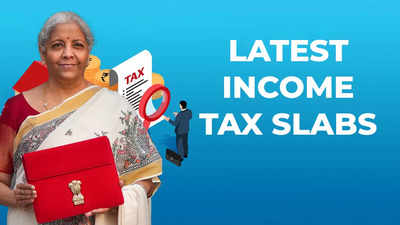Latest income tax slabs FY 2025-26: Finance Minister Nirmala Sitharaman announced sweeping changes in the new income tax regime, announcing revamped income tax slabs and income tax rates for the salaried taxpayers, individual taxpayers, common man and middle class. The biggest announcement was that people earning up to Rs 12 lakh income will not have to pay income tax!
The three pillars – Democracy, Demography and Demand – form the foundation for our progression towards Viksit Bharat.India’s middle class serves as a crucial driving force for economic advancement. The current administration, led by Prime Minister Modi, recognises the middle class’s vital contribution and capabilities in building the nation, FM Nirmala Sitharaman said.
Latest Income Tax Slabs FY 2025-26 Under New Tax Regime
With effect from assessment year 2026-27, it is proposed that the following rates provided under the proposed clause (iii) of sub-section (1A) of section 115BAC of the Act shall be the rates applicable for determining the income-tax payable in respect of the total income of a person, being an individual or Hindu undivided family or association of persons [other than a co-operative society], or body of individuals, whether incorporated or not, or an artificial juridical person referred to in subclause (vii) of clause (31) of section 2:—
Acknowledging the role of middle class, FM Sitharaman said that they have consistently reduced middle class income taxation burden. Since 2014, the ‘Nil tax’ threshold has seen progressive increases: initially to Rs 2.5 lakh, then to Rs 5 lakh in 2019, and subsequently to Rs 7 lakh in 2023, demonstrating the government’s confidence in middle-class taxpayers.
A significant announcement introduces tax exemption for incomes up to Rs 12 lakh under the new regime (excluding special rate income like capital gains). For salaried individuals, this threshold extends to Rs 12.75 lakh, factoring in the standard deduction of Rs 75,000.
Also Check | Income Tax Slabs 2025-26 Budget 2025 Live Updates
The comprehensive revision of tax slabs and rates aims to benefit all taxpayers, particularly enabling the middle class to retain more disposable income, which should enhance household spending, savings and investment potential.
Latest Income Tax Slabs FY 2025-26 Under Old Tax Regime
The income tax slabs for FY 2025-26 under the old income tax regime continue to be the same:
- Annual earnings up to Rs 2,50,000 are exempt from taxation
- 5% tax applies on earnings between Rs 2,50,001 and Rs 5,00,000
- 20% tax rate for income range of Rs 5,00,001 to Rs 10,00,000
- Earnings exceeding Rs 10,00,000 are taxed at 30%
How much income do I save post Budget 2025?
For regular income up to Rs 12 lakh (excluding special rate income such as capital gains), taxpayers receive a tax rebate alongside benefits from reduced slab rates, effectively eliminating their tax liability.
The impact of these modifications can be quantified through specific examples:
– At Rs 12 lakh income level: Rs 80,000 tax benefit (complete tax exemption)
– At Rs 18 lakh income level: Rs 70,000 tax reduction (30% of previous tax liability)
– At Rs 25 lakh income level: Rs 1,10,000 tax saving (25% of previous tax liability)
Latest Income Tax Slabs FY 2025-26: FAQs Answered
What are the new tax slabs rules?
The new income tax slabs have been announced by FM Nirmala Sitharaman. These tax slabs and rates are applicable for the new income tax regime. In this article, a detailed table shows the latest income tax slabs for FY 2025-26.
How is income tax calculated on new slabs?
In order to calculate income tax under the new tax regime, an individual needs to first determine their gross income by adding earnings from all sources, such as salary, property, and other sources etc. Next, they should apply the rates available under new tax regime to their income. After calculating the tax for each income slab, sum these amounts to find the total tax. Then, add the Health and Education Cess (4%) and surcharge (if applicable) to determine the final tax liability.
Unlike the old regime, the new tax regime does not allow most deductions, such as those under Section 80C or for HRA, but some exemptions remain, such as the employer’s contribution to NPS.
What is the latest income tax rebate limit under Section 87A?
From assessment year 2026-27 onwards, for an assessee, being an individual resident in India whose income is chargeable to tax under the sub-section (1A) of section 115BAC, it is proposed to,–
(i) enhance the limit of total income for rebate in clause (a) and (b) of first proviso under section 87A, on which the income-tax is payable as per the rates of income-tax under sub-section (1A) of section 115BAC, from Rs. 7,00,000/- to Rs. 12,00,000/- and the limit of rebate in clause (a) of first proviso to section 87A from Rs. 25,000/- to Rs. 60,000/-.
(ii) rationalise the first proviso to section 87A by inserting a new proviso so as to provide that the deduction under the first proviso, shall not exceed the amount ofincome-tax payable as per the rates provided in sub-section (1A) of section 115BAC.




